Publications
2023
Gamba, Oscar; Eder, Moritz; Poglitsch, Matthias; Pavelec, Jiri; Sombut, Panukorn; Meier, Matthias; Diebold, Ulrike; Schmid, Michael; Parkinson, Gareth S.
Formation and stability of Fe-rich terminations of the Fe3O4(001) surface
Journal ArticleOpen AccessIn: Materials Research Express, vol. 10, iss. 44, no. 116517, 2023.
Abstract | Links | BibTeX | Tags: P02, P04
@article{Gamba2023,
title = {Formation and stability of Fe-rich terminations of the Fe_{3}O_{4}(001) surface},
author = {Oscar Gamba and Moritz Eder and Matthias Poglitsch and Jiri Pavelec and Panukorn Sombut and Matthias Meier and Ulrike Diebold and Michael Schmid and Gareth S. Parkinson},
doi = {10.1088/2053-1591/ad0ac5},
year = {2023},
date = {2023-11-22},
urldate = {2023-11-22},
journal = {Materials Research Express},
volume = {10},
number = {116517},
issue = {44},
publisher = {IOP Publishing},
abstract = {Understanding how the structure of iron oxide surfaces varies with their environment is essential for rationalizing their role in (geo-)chemistry and optimizing their application in modern technologies. In this paper, we create Fe-rich terminations of Fe_{3}O_{4}(001) by depositing iron directly onto the 'subsurface cation vacancy'-reconstructed surface, which is the most stable surface under ultrahigh vacuum conditions. Scanning tunneling microscopy and x-ray photoelectron spectroscopy data reveal that the excess iron is initially accommodated as two-fold coordinated adatoms and later incorporates into the subsurface cation vacancies. As the coverage increases, small patches of the octahedral pair termination (also known as the 'Fe dimer' termination) nucleate, eventually covering the entire surface after the deposition of 2 iron atoms per (√2×√2)R45° unit cell. This conclusion effectively rules out some existing models for the termination and provides support for the model proposed by Rustad \textit{et al.} (Surface Science 432, L583-L588, 1999), highlighting the need for further theoretical work to complete the Fe_{3}O_{4}(001) surface phase diagram. The octahedral pair termination is found to be unstable above 523 K and upon exposure to molecular O2 because the excess iron atoms agglomerate to form small FeO_{x} clusters.},
keywords = {P02, P04},
pubstate = {published},
tppubtype = {article}
}
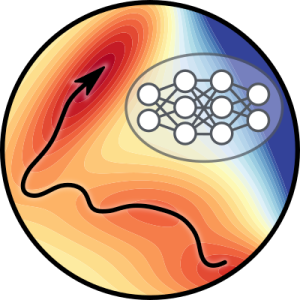
Domenichini, Giorgio; Dellago, Christoph
Molecular Hessian matrices from a machine learning random forest regression algorithm
Journal ArticleOpen AccessIn: The Journal of Chemical Physics, vol. 159, iss. 19, no. 194111, 2023.
Abstract | Links | BibTeX | Tags: P12
@article{10.1063/5.0169384,
title = {Molecular Hessian matrices from a machine learning random forest regression algorithm},
author = {Giorgio Domenichini and Christoph Dellago},
doi = {https://doi.org/10.1063/5.0169384},
year = {2023},
date = {2023-11-20},
urldate = {2023-11-20},
journal = {The Journal of Chemical Physics},
volume = {159},
number = {194111},
issue = {19},
abstract = {In this article, we present a machine learning model to obtain fast and accurate estimates of the molecular Hessian matrix. In this model, based on a random forest, the second derivatives of the energy with respect to redundant internal coordinates are learned individually. The internal coordinates together with their specific representation guarantee rotational and translational invariance. The model is trained on a subset of the QM7 dataset but is shown to be applicable to larger molecules picked from the QM9 dataset. From the predicted Hessian, it is also possible to obtain reasonable estimates of the vibrational frequencies, normal modes, and zero point energies of the molecules.},
keywords = {P12},
pubstate = {published},
tppubtype = {article}
}
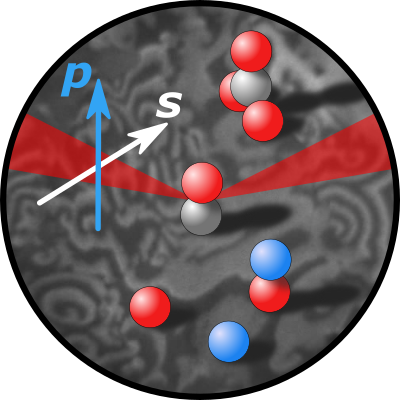
Raab, Maximilian; Zeininger, Johannes; Suchorski, Yuri; Genest, Alexander; Weigl, Carla; Rupprechter, Günther
Lanthanum modulated reaction pacemakers on a single catalytic nanoparticle
Journal ArticleOpen AccessIn: Nature Communications, vol. 14, no. 7186, 2023.
Abstract | Links | BibTeX | Tags: P08
@article{Raab2023b,
title = {Lanthanum modulated reaction pacemakers on a single catalytic nanoparticle},
author = {Maximilian Raab and Johannes Zeininger and Yuri Suchorski and Alexander Genest and Carla Weigl and Günther Rupprechter},
doi = {10.1038/s41467-023-43026-3},
year = {2023},
date = {2023-11-08},
urldate = {2023-11-08},
journal = {Nature Communications},
volume = {14},
number = {7186},
abstract = {Promoters are important in catalysis, but the atomistic details of their function and particularly their role in reaction instabilities such as kinetic phase transitions and oscillations are often unknown. Employing hydrogen oxidation as probe reaction, a Rh nanotip for mimicking a single Rh nanoparticle and field electron microscopy for in situ monitoring, we demonstrate a La-mediated local catalytic effect. The oscillatory mode of the reaction provides a tool for studying the interplay between different types of reaction pacemakers, i.e., specific local surface atomic configurations that initiate kinetic transitions. The presence of La shifts the bistable reaction states, changes the oscillation pattern and deactivates one of two pacemaker types for the La-free surface. The observed effects originate from the La-enhanced oxygen activation on the catalyst. The experimental observations are corroborated by micro-kinetic model simulations comprising a system of 25 coupled oscillators.},
keywords = {P08},
pubstate = {published},
tppubtype = {article}
}
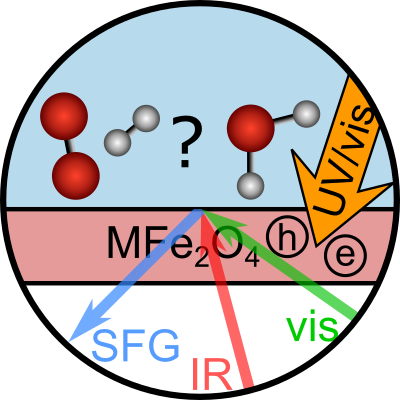
Buessler, Martin; Maruyama, Shingo; Zelenka, Moritz; Onishi, Hiroshi; Backus, Ellen H. G.
Journal ArticleOpen AccessIn: Physical Chemistry Chemical Physics, vol. 25, pp. 31471–31480, 2023.
Abstract | Links | BibTeX | Tags: P11
@article{Buessler2023,
title = {Unravelling the interfacial water structure at the photocatalyst strontium titanate by sum frequency generation spectroscopy},
author = {Martin Buessler and Shingo Maruyama and Moritz Zelenka and Hiroshi Onishi and Ellen H. G. Backus},
doi = {https://doi.org/10.1039/D3CP03829G},
year = {2023},
date = {2023-10-31},
urldate = {2023-10-31},
journal = {Physical Chemistry Chemical Physics},
volume = {25},
pages = {31471--31480},
abstract = {The direct conversion of solar energy to hydrogen is considered as a possible method to produce carbon neutral hydrogen fuel. The mechanism of photocatalytic water splitting involves the chemical breakdown of water and re-assembly into hydrogen and oxygen at the interface of a photocatalyst. The selection rules of a suitable material are well established, but the fundamental understanding of the mechanisms, occurring at the interface between the catalyst and the water, remains missing. Using surface specific sum frequency generation spectroscopy, we present here characterisation of the interface between water and the photocatalyst strontium titanate (SrTiO_{3}). We monitor the OH-stretching vibrations present at the interface. Their variations of intensities and frequencies as functions of isotopic dilution, pH and salt concentration provide information about the nature of the hydrogen bonding environment. We observe the presence of water molecules that flip their orientation at pH 5 indicating the point of zero charge of the SrTiO_{3} layer. These water molecules are oriented with their hydrogen away from the surface when the pH of the solutions is below 5 and pointing towards the surface when the pH is higher than 5. Besides, water molecules donating a H-bond to probably surface TiOH groups are observed at all pH.},
keywords = {P11},
pubstate = {published},
tppubtype = {article}
}

Phichairatanaphong, Orrakanya; Yigit, Nevzat; Rupprechter, Günther; Chareonpanich, Metta; Donphai, Waleeporn
Journal ArticleOpen AccessIn: Industrial & Engineering Chemistry Research, vol. 62, iss. 40, pp. 16254–16267, 2023.
Abstract | Links | BibTeX | Tags:
@article{Phichairatanaphong2023,
title = {Highly Efficient Conversion of Greenhouse Gases Using a Quadruple Mixed Oxide-Supported Nickel Catalyst in Reforming Process},
author = {Orrakanya Phichairatanaphong and Nevzat Yigit and Günther Rupprechter and Metta Chareonpanich and Waleeporn Donphai},
doi = {10.1021/acs.iecr.3c02030},
year = {2023},
date = {2023-10-02},
urldate = {2023-10-02},
journal = {Industrial & Engineering Chemistry Research},
volume = {62},
issue = {40},
pages = {16254--16267},
abstract = {The greenhouse gas reduction as well as the utilization of more renewable and clean energy via a dry reforming reaction is of interest. The impact of a CeMgZnAl oxide quad-blend-supported Ni catalyst on performance and anticoking during dry reforming reactions at 700 °C was studied. A high Ce–Mg/Zn ratio, as seen in the CeMg_{0.5}ZnAl-supported nickel catalyst, enhances lattice oxygen, and the presence of strong basic sites, along with the creation of the carbonate intermediate species, is accompanied by the production of gaseous CO through a gasification reaction between the carbon species and Ni-CO_{ads-lin} site. The phenomena caused the outstanding performance of the Ni/CeMg_{0.5}ZnAl catalyst─CH_{4} (84%), CO_{2} (83%) conversions, and the H_{2}/CO (0.80) ratio; moreover, its activity was also stable throughout 30 h.},
keywords = {},
pubstate = {published},
tppubtype = {article}
}

Falkner, Sebastian; Coretti, Alessandro; Romano, Salvatore; Geissler, Phillip L.; Dellago, Christoph
Conditioning Boltzmann generators for rare event sampling
Journal ArticleOpen AccessIn: Machine Learning: Science and Technology, vol. 4, iss. 3, no. 035050, 2023.
Abstract | Links | BibTeX | Tags: P12
@article{Falkner_2023,
title = {Conditioning Boltzmann generators for rare event sampling},
author = {Sebastian Falkner and Alessandro Coretti and Salvatore Romano and Phillip L. Geissler and Christoph Dellago},
url = {https://arxiv.org/abs/2207.14530},
doi = {10.1088/2632-2153/acf55c},
year = {2023},
date = {2023-09-22},
urldate = {2023-09-22},
journal = {Machine Learning: Science and Technology},
volume = {4},
number = {035050},
issue = {3},
abstract = {Understanding the dynamics of complex molecular processes is often linked to the study of infrequent transitions between long-lived stable states. The standard approach to the sampling of such rare events is to generate an ensemble of transition paths using a random walk in trajectory space. This, however, comes with the drawback of strong correlations between subsequently sampled paths and with an intrinsic difficulty in parallelizing the sampling process. We propose a transition path sampling scheme based on neural-network generated configurations. These are obtained employing normalizing flows, a neural network class able to generate statistically independent samples from a given distribution. With this approach, not only are correlations between visited paths removed, but the sampling process becomes easily parallelizable. Moreover, by conditioning the normalizing flow, the sampling of configurations can be steered towards regions of interest. We show that this approach enables the resolution of both the thermodynamics and kinetics of the transition region for systems that can be sampled using exact-likelihood generative models.},
keywords = {P12},
pubstate = {published},
tppubtype = {article}
}
Puntscher, Lena; Sombut, Panukorn; Wang, Chunlei; Ulreich, Manuel; Pavelec, Jiri; Rafsanjani-Abbasi, Ali; Meier, Matthias; Lagin, Adam; Setvin, Martin; Diebold, Ulrike; Franchini, Cesare; Schmid, Michael; Parkinson, Gareth S.
A Multitechnique Study of C2H4 Adsorption on Fe3O4(001)
Journal ArticleOpen AccessIn: Journal of Physical Chemistry C, vol. 127, iss. 37, pp. 18378–18388, 2023.
Abstract | Links | BibTeX | Tags: P02, P04, P07
@article{Puntscher2023,
title = {A Multitechnique Study of C_{2}H_{4} Adsorption on Fe_{3}O_{4}(001)},
author = {Lena Puntscher and Panukorn Sombut and Chunlei Wang and Manuel Ulreich and Jiri Pavelec and Ali Rafsanjani-Abbasi and Matthias Meier and Adam Lagin and Martin Setvin and Ulrike Diebold and Cesare Franchini and Michael Schmid and Gareth S. Parkinson},
doi = {10.1021/acs.jpcc.3c03684},
year = {2023},
date = {2023-09-11},
urldate = {2023-09-11},
journal = {Journal of Physical Chemistry C},
volume = {127},
issue = {37},
pages = {18378--18388},
publisher = {American Chemical Society (ACS)},
abstract = {The adsorption/desorption of ethene (C_{2}H_{4}), also commonly known as ethylene, on Fe_{3}O_{4}(001) was studied under ultrahigh vacuum conditions using temperature-programmed desorption (TPD), scanning tunneling microscopy, X-ray photoelectron spectroscopy, and density functional theory (DFT)-based computations. To interpret the TPD data, we have employed a new analysis method based on equilibrium thermodynamics. C_{2}H_{4} adsorbs intact at all coverages and interacts most strongly with surface defects such as antiphase domain boundaries and Fe adatoms. On the regular surface, C_{2}H_{4} binds atop surface Fe sites up to a coverage of 2 molecules per (√2 × √2)R45° unit cell, with every second Fe occupied. A desorption energy of 0.36 eV is determined by analysis of the TPD spectra at this coverage, which is approximately 0.1–0.2 eV lower than the value calculated by DFT + U with van der Waals corrections. Additional molecules are accommodated in between the Fe rows. These are stabilized by attractive interactions with the molecules adsorbed at Fe sites. The total capacity of the surface for C_{2}H_{4} adsorption is found to be close to 4 molecules per (√2 × √2)R45° unit cell.},
keywords = {P02, P04, P07},
pubstate = {published},
tppubtype = {article}
}
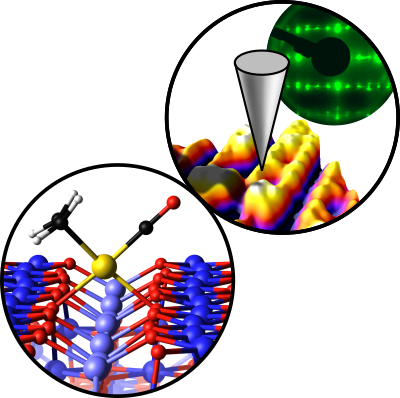
Redondo, Jesús; Michalička, Jan; Kraushofer, Florian; Franceschi, Giada; Šmid, Břetislav; Kumar, Nishant; Man, Ondřej; Blatnik, Matthias; Wrana, Dominik; Mallada, Benjamin; Švec, Martin; Parkinson, Gareth S.; Setvin, Martin; Riva, Michele; Diebold, Ulrike; Čechal, Jan
Journal ArticleOpen AccessIn: Advanced Materials Interfaces, no. 2300602, 2023.
Abstract | Links | BibTeX | Tags: P02, P04
@article{Redondo2023,
title = {Hematite α-Fe_{2}O_{3}(0001) in Top and Side View: Resolving Long-Standing Controversies about Its Surface Structure},
author = {Jesús Redondo and Jan Michalička and Florian Kraushofer and Giada Franceschi and Břetislav Šmid and Nishant Kumar and Ondřej Man and Matthias Blatnik and Dominik Wrana and Benjamin Mallada and Martin Švec and Gareth S. Parkinson and Martin Setvin and Michele Riva and Ulrike Diebold and Jan Čechal},
doi = {10.1002/admi.202300602},
year = {2023},
date = {2023-08-18},
urldate = {2023-08-18},
journal = {Advanced Materials Interfaces},
number = {2300602},
publisher = {Wiley},
abstract = {Hematite is a common iron oxide found in nature, and the α-Fe_{2}O_{3}(0001) plane is prevalent on the nanomaterial utilized in photo- and electrocatalytic applications. The atomic-scale structure of the surface remains controversial despite decades of study, partly because it depends on sample history as well as the preparation conditions. Here, a comprehensive study is performed using an arsenal of surface techniques (non-contact atomic force microscopy, scanning tunneling microscopy, low-energy electron diffraction, and X-ray photoemission spectroscopy) complemented by analyses of the near surface region by high-resolution transmission electron microscopy and electron energy loss spectroscopy. The results show that the so-called “bi-phase” termination forms even under highly oxidizing conditions; a (1 × 1) surface is only observed in the presence of impurities. Furthermore, it is shown that the biphase is actually a continuous layer distorted due to a mismatch with the subsurface layers, and thus not the proposed mixture of FeO(111) and α-Fe_{2}O_{3}(0001) phases. Overall, the results show how combining surface and cross-sectional imaging provides a full view that can be essential for understanding the role of the near-surface region on oxide surface properties.},
keywords = {P02, P04},
pubstate = {published},
tppubtype = {article}
}
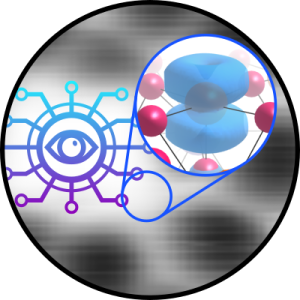
Tresca, Cesare; Forcella, Pietro Maria; Angeletti, Andrea; Ranalli, Luigi; Franchini, Cesare; Reticcioli, Michele; Profeta, Gianni
Evidence of Molecular Hydrogen in the N-doped LuH3 System: a Possible Path to Superconductivity?
Journal ArticleSubmittedarXivIn: arXiv, 2023.
Abstract | Links | BibTeX | Tags: P07
@article{Tresca2024,
title = {Evidence of Molecular Hydrogen in the N-doped LuH3 System: a Possible Path to Superconductivity?},
author = {Cesare Tresca and Pietro Maria Forcella and Andrea Angeletti and Luigi Ranalli and Cesare Franchini and Michele Reticcioli and Gianni Profeta},
url = {https://arxiv.org/abs/2308.03619},
year = {2023},
date = {2023-08-07},
urldate = {2023-08-07},
journal = {arXiv},
abstract = {The report of near-ambient superconductivity in nitrogen-doped lutetium hydrides could represent an epochal discovery, awaited for more than a century, possibly leading to inconceivable scientific and technological implications. However, after months since the first report, clear experimental and theoretical confirmations are yet to come: The initially proposed compound structure fails to explain the superconducting behavior, calling for a shift in perspective. By means of machine-learning-accelerated force-field molecular dynamics, we explore the formation of H_{2} molecules in nitrogen-doped lutetium hydride, demonstrating the active role of nitrogen in stabilizing this phase. Our density functional theory calculations show that the presence of hydrogen molecules leads to a dynamically stable structure, characterized by a superconducting phase requiring no applied pressure, although the predicted temperatures are still much lower than room temperature. We believe that the possibility to stabilize hydrogen in molecular form represents a new route to explore disordered phases in hydrides and their transport properties at near ambient conditions.},
keywords = {P07},
pubstate = {published},
tppubtype = {article}
}

Tangpakonsab, Parinya; Genest, Alexander; Yang, Jingxia; Meral, Ali; Zou, Bingjie; Yigit, Nevzat; Schwarz, Sabine; Rupprechter, Günther
Kinetic and Computational Studies of CO Oxidation and PROX on Cu/CeO2 Nanospheres
Journal ArticleOpen AccessIn: Topics in Catalysis, vol. 66, pp. 1129–1142, 2023.
Abstract | Links | BibTeX | Tags: P08
@article{Tangpakonsab2023,
title = {Kinetic and Computational Studies of CO Oxidation and PROX on Cu/CeO_{2} Nanospheres},
author = {Parinya Tangpakonsab and Alexander Genest and Jingxia Yang and Ali Meral and Bingjie Zou and Nevzat Yigit and Sabine Schwarz and Günther Rupprechter},
doi = {10.1007/s11244-023-01848-x},
year = {2023},
date = {2023-07-31},
journal = {Topics in Catalysis},
volume = {66},
pages = {1129--1142},
publisher = {Springer Science and Business Media LLC},
abstract = {As supported CuO is well-known for low temperature activity, CuO/CeO_{2} nanosphere catalysts were synthesized and tested for CO oxidation and preferential oxidation of CO (PROX) in excess H_{2}. For the first reaction, ignition was observed at 95 °C, whereas selective PROX occurred in a temperature window from 50 to 100 °C. The catalytic performance was independent of the initial oxidation state of the catalyst (CuO vs. Cu^{0}), suggesting that the same active phase is formed under reaction conditions. Density functional modeling was applied to elucidate the intermediate steps of CO oxidation, as well as those of the comparably less feasible H_{2} transformation. In the simulations, various Cu and vacancy sites were probed as reactive centers enabling specific pathways.},
keywords = {P08},
pubstate = {published},
tppubtype = {article}
}
